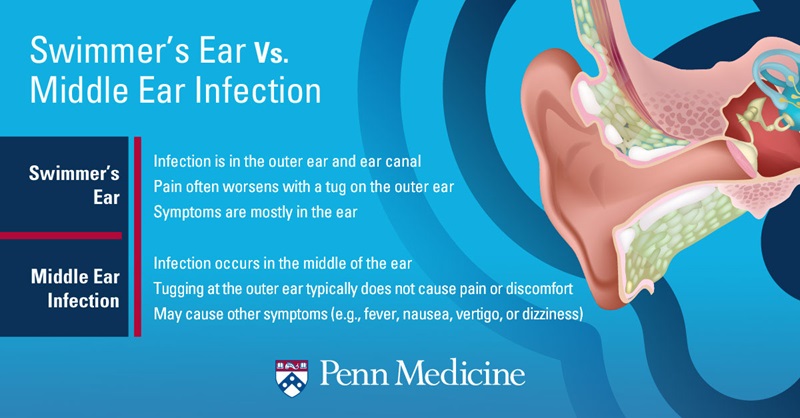It feels like a bubble in your ear, and every sound is muffled. Your ear is starting to itch, and water is coming out. As pain sets in, you realize: You take for granted how nice life is without ear pain.
Pain in the ears often stems from an ear infection. If the infection is in the outer ear or ear canal, it is called otitis externa — more commonly known as, swimmer’s ear.
Swimmer’s ear is different than the middle ear infections, known as otitis media, that are common among children.
“Swimmer’s ear is rarely serious, but the infection can become severe if it spreads to other areas around the ear, such as the skull,” says Dr. Paula Barry, physician at Penn Family and Internal Medicine Longwood. The good news: It is usually treatable with topical antibiotics.

Swimmer’s Ear: Not Just for Swimmers
Although swimmer’s ear is more common in children and young adults, you can get it at any age. And you don’t even have to be swimming. In most cases, swimmer’s ear occurs when water or moisture is trapped in the ear canal. That means you can get it from taking showers or baths, washing your hair, or being in a moist or humid environment.
Swimmer’s ear can also come from something getting stuck inside the ear, excessive ear cleaning, or contact with chemicals like hair dye or hairspray. If you have skin conditions that affect the ear canal, such as eczema or psoriasis, you may be more prone to developing swimmer’s ear. In addition, individuals that wear ear plugs, ear buds, or hearing aids may be at an increased risk.
10 Things You Should Know About Swimmer’s Ear
Fortunately, swimmer’s ear is treatable — and regular ear care can help prevent it.
1. Blame It on the Bacteria
It’s not necessarily the water that causes swimmer’s ear — it’s the bacteria. Excess water in the ear keeps the ear moist, which makes it the perfect place for these germs and bacteria to stay and grow.
2. You Need Earwax
Extra water in the ear can also remove earwax, which makes the ear the ideal host for germs and fungi. And while earwax may seem gross, a certain amount of ear wax is beneficial and actually protects you by stopping dust or other harmful objects from getting into your ear.
3. Clean Ears Are Not Wax-Free
Since earwax plays an important role in preventing infection, leave it alone. “If you develop excess ear wax, talk to your physician about the best method of removal,” suggests Dr. Barry. That means ignoring grandma’s advice to stick a cotton swab in your ear to “clean your ears out.” Instead of removing wax, cotton swabs often push it closer to the eardrum. This can then affect your hearing. Dr. Barry states, “It is best to follow the age-old recommendation of physicians to not put anything smaller than your elbow in your ear.”
4. Keep ‘Em Dry
Use ear plugs, a bathing cap, or wetsuit hood to keep water from getting in your ears. Then, use a towel to dry off your ears as soon as you’re done swimming or bathing.
5. Get the Water Out
If you do end up with water in your ears, getting the water out can prevent swimmer’s ear. Try tilting your head or pulling the earlobe in different directions. If that doesn’t work, you can also try holding a hair dryer on a low setting several inches from your ear until the ear feels dry.
6. What’s Up, Doc?
Treating swimmer’s ear starts with your physician. They can remove pus or drainage and make sure that the infection isn’t coming from, or causing another problem. They may need to remove some debris from the ear canal so that the antibiotic drops can reach the site of infection. Talk to your physician as soon as you suspect swimmer’s ear so that you can get treatment right away to prevent the infection from spreading.
7. Listen to Your Physician
Follow your physician’s advice, and do not put anything in your ears other than the prescribed medicine. Avoid scratching or rubbing your ears so you don’t make them worse. If you’re still in pain, try placing a warm compress or towel on your ear.
8. Stay Dry
While you’re treating swimmer’s ear, keep your ear as dry as possible for about 7 to 10 days. Take baths rather than showers and avoid swimming or playing water sports. A large cotton ball with petroleum jelly on it can be placed into the outer ear area to avoid getting water in the ear while bathing. Ask your physician before returning to swimming.
9. What’s Up Again, Doc?
Contact your physician again if symptoms don’t clear up with treatment after 7 days, or if you have new symptoms, such as fever, pain, or redness on the skin around the ear.
10. Be Gone, Swimmer’s Ear
Swimmer’s ear is usually treatable with a 7 to 10-day course of antibiotic ear drops. Your physician may also prescribe acetic acid ear drops to help prevent another infection. In addition, ibuprofen or acetaminophen may be recommended to relieve pain. If the infection has spread beyond the outer ear, you may need to take antibiotics by mouth.